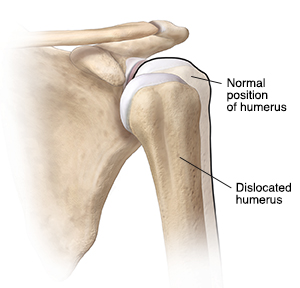Shoulder Dislocation
What is a shoulder dislocation?
If you have dislocated your shoulder, your upper arm bone (humerus) has moved out of your shoulder joint. This is the most frequently dislocated major joint of your body. Dislocation is often caused by a major force that separates your shoulder joint's ball (the top rounded part of your upper arm bone) from your joint's socket (glenoid).

What causes a shoulder dislocation?
Your shoulder can dislocate in several ways, including:
-
Forward and downward dislocation (anterior dislocation) . These are the most common types of dislocations. They often result from falling on your outstretched hand or on the shoulder itself.
-
Backward dislocation (posterior dislocation). This type of dislocation may be caused by a direct blow to the front of your shoulder, or the violent twisting of your upper arm.
Your shoulder can be either partly or fully dislocated. Partial dislocation is when the head of your upper arm is partly out of your shoulder socket. Complete dislocation is when the head of your upper arm is completely out of your shoulder socket.
What are the symptoms of a shoulder dislocation?
Symptoms may be different for each person. Symptoms may include:
-
Pain in your upper arm and shoulder, which is often worse when you try to move them
-
Swelling
-
Numbness and weakness
-
Bruising
-
Deformity of your shoulder
These symptoms may be caused by other conditions or health problems. Always talk with your healthcare provider for a diagnosis.
How is a shoulder dislocation diagnosed?
Your healthcare provider will take a full health history and give you a physical exam. Diagnostic tests often include X-rays and an MRI.
How is a shoulder dislocation treated?
Treatment will depend on your symptoms, age, and general health. It will also depend on how severe the condition is.
Treatment may include:
-
Moving the head of your upper arm bone back into your shoulder joint (reduction), often with an anesthetic
-
Limiting shoulder movement (immobilization) with a sling after reduction
-
Rehab (rehabilitation)
-
Surgery, if nonsurgical methods don't restore stability
What can I do to prevent a shoulder dislocation?
Keeping muscle strength and flexibility can help prevent shoulder dislocations. Once your shoulder is dislocated, physical therapy may help prevent you from dislocating it in the future. By restoring your shoulder’s range of motion and physical strength, your risk for dislocation decreases.
How is a shoulder dislocation managed?
Once your shoulder has been placed back into the socket joint, your healthcare provider may advise you to keep your shoulder immobilized. This is done by using a sling or other device for a few weeks after treatment. Resting and applying ice to the affected area several times a day will help reduce your pain and swelling. Your healthcare provider may prescribe medicine to reduce pain and inflammation. Take the medicine as directed.
After your pain and swelling go away, you may need to do some rehab exercises to help restore your shoulder’s range of motion and strengthen your muscles.
When should I call my healthcare provider?
Contact your healthcare provider if you have these symptoms:
-
Severe pain in your shoulder when you try to move your arm
-
Swelling, pain, or both that gets worse in your shoulder, arm, or hand
-
Your arm or hand turns purple or pale
-
You have a fever or chills
Shoulder dislocation can damage blood vessels and nerves that feed the arm and hand. Getting medical care right away can improve the outcome.
Key points about shoulder dislocation
-
Shoulder dislocation means your upper arm bone has come out of your shoulder joint.
-
Your shoulder can dislocate forward and downward, and backward. It can be partly or fully dislocated.
-
A dislocated shoulder is very painful.
-
If you had a dislocated shoulder in the past, you are at greater risk for having it happen again.
-
After you've eased your early pain, rehab exercises will help you prevent future dislocation.
-
Maintaining muscle strength and flexibility can help prevent shoulder dislocations.
Next steps
Tips to help you get the most from a visit to your healthcare provider:
-
Know the reason for your visit and what you want to happen.
-
Before your visit, write down questions you want answered.
-
Bring someone with you to help you ask questions and remember what your provider tells you.
-
At the visit, write down the name of a new diagnosis, and any new medicines, treatments, or tests. Also write down any new instructions your provider gives you.
-
Know why a new medicine or treatment is prescribed, and how it will help you. Also know what the side effects are.
-
Ask if your condition can be treated in other ways.
-
Know why a test or procedure is recommended and what the results could mean.
-
Know what to expect if you do not take the medicine or have the test or procedure.
-
If you have a follow-up appointment, write down the date, time, and purpose for that visit.
-
Know how you can contact your provider if you have questions.
Online Medical Reviewer:
Raymond Turley Jr PA-C
Online Medical Reviewer:
Stacey Wojcik MBA BSN RN
Online Medical Reviewer:
Thomas N Joseph MD
Date Last Reviewed:
4/1/2022
© 2000-2024 The StayWell Company, LLC. All rights reserved. This information is not intended as a substitute for professional medical care. Always follow your healthcare professional's instructions.